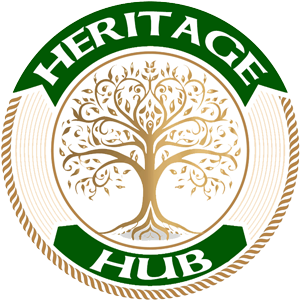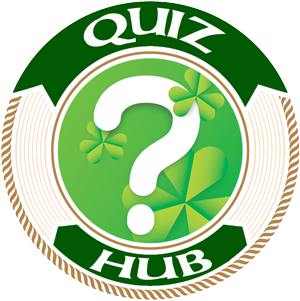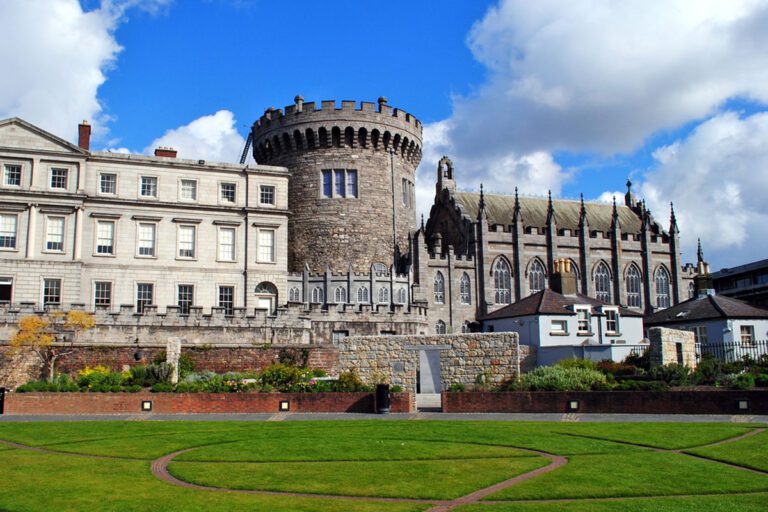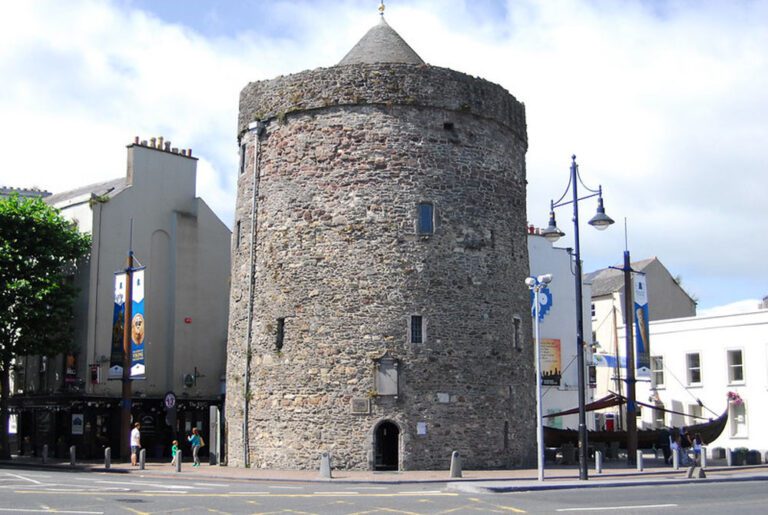The Viking Beginnings Dublin Castle, a landmark steeped in Irish history, traces its origins back over a thousand years. Its journey from a Viking settlement to the seat of British and later Irish rule reflects Ireland’s complex history of conquest, resistance,...
Read More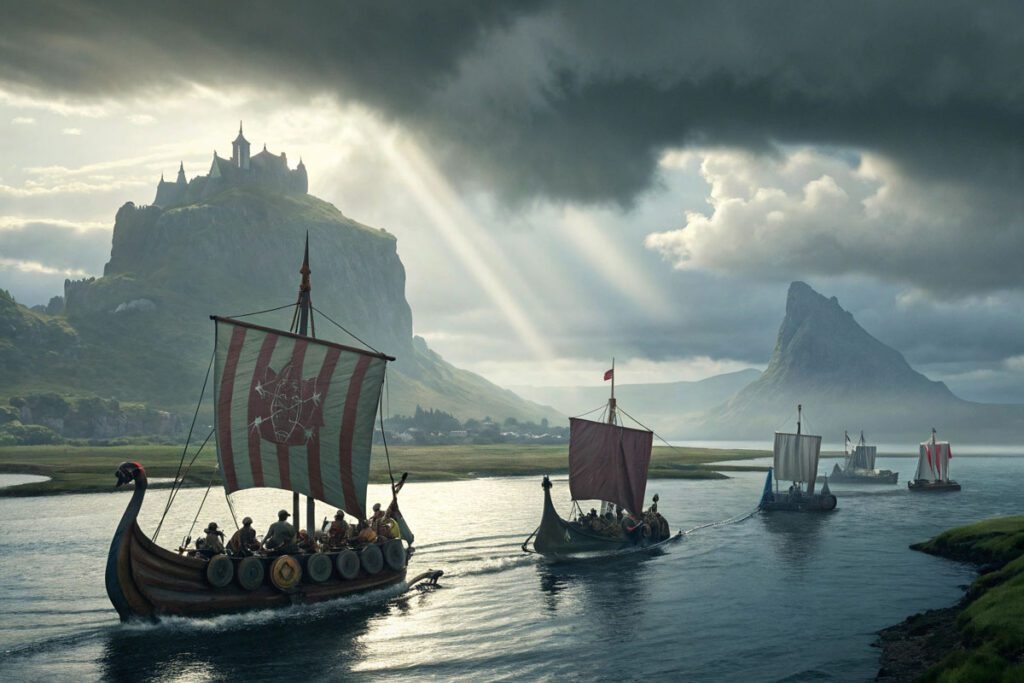
Vikings and Ireland: Fact, Fiction, and Filming
Welcome to the crossroads of myth and history—where Norse raiders, Irish kings, and Hollywood storytelling meet on Irish soil.
Whether you’re a fan of the TV show Vikings, intrigued by the real-life Norse invasions, or planning a visit to one of the series’ dramatic filming locations, we have you covered. Ireland played a central role in both the real Viking era and the cinematic world of Ragnar, Lagertha, and their descendants. Here, you’ll find out how fact and fiction intertwine—and how Ireland became a character in its own right.
The Real Viking History in Ireland
Learn about the Norse raiders who came to Ireland in the 8th century, how they founded cities like Dublin and Waterford, and their lasting influence on Irish culture, trade, and warfare.Filming Vikings in Ireland: Behind the Scenes
Discover how Irish landscapes—from the valleys of Wicklow to the lakes of Kerry—were transformed into the rugged world of Kattegat. Get insights into how the production chose locations, built sets, and worked with local crews.Vikings Filming Locations You Can Visit
Plan your own Norse-inspired journey with our guide to real filming locations. Visit Lough Tay (aka “Kattegat”), Ashford Studios, and nearby villages that featured in the series.Vikings: Valhalla and Ireland’s Ongoing Role
The saga continues with Vikings: Valhalla—and once again, Ireland is in the spotlight. Learn how the new series built on the legacy of its predecessor while showcasing new parts of the country.Pop Culture Meets Heritage
See how the popularity of the show has sparked renewed interest in Irish Viking heritage. From festivals and reenactments to guided tours and museum exhibits, Viking Ireland is having a cultural revival.- Vikings in Ireland Quiz
Test your knowledge of Norse history in Ireland with this quick quiz on Viking raids, settlements, and influence.
Whether you’re here to follow in the footsteps of legendary warriors or explore the deep roots of Norse-Irish history, this is your gateway to the full Viking-Ireland experience—where every story has two sides: one carved in stone, the other written for the screen.
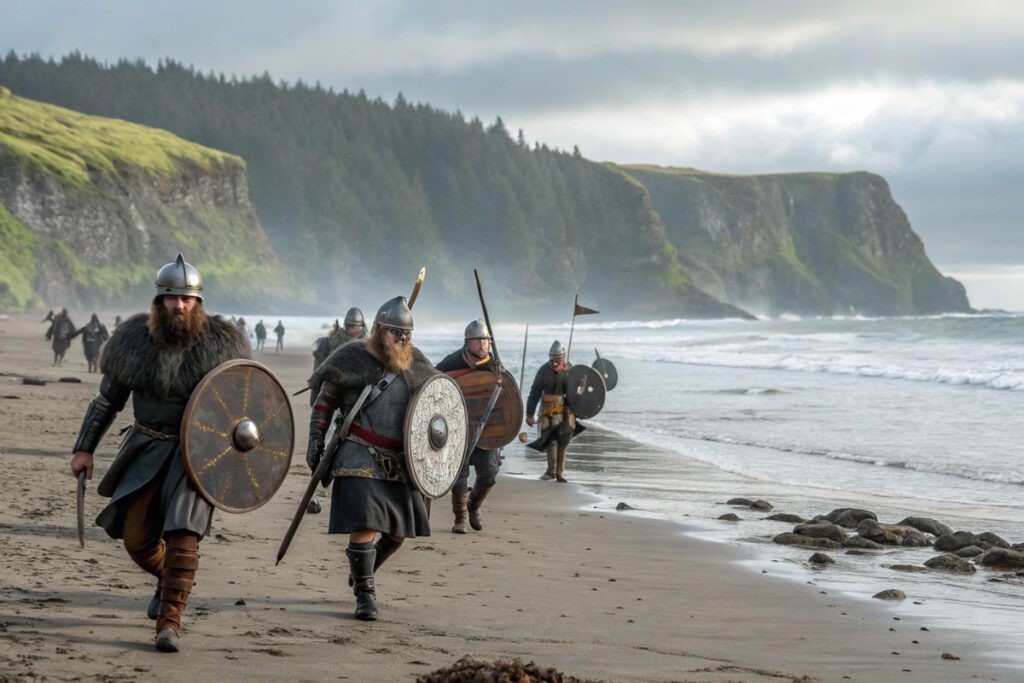
The Real Viking History in Ireland
Long before Vikings was a hit TV series, the Norsemen had already left their mark on Ireland. From brutal raids to city building, their presence shaped Irish politics, culture, and trade for centuries. The real story of the Vikings in Ireland is just as dramatic—if not more so—than the fiction.
The First Raids: A Violent Arrival (795 AD onwards)
The Viking story in Ireland begins in 795 AD, when Norse raiders attacked the island monastery of Lambay. Over the next few decades, coastal monasteries—rich in gold, manuscripts, and unarmed monks—became prime targets. These early raids were swift and seasonal, but by the mid-9th century, things changed.
From Raiders to Settlers
Around 840 AD, Vikings began to establish longphorts (fortified ship encampments) along Ireland’s rivers, including in Dublin, Cork, Limerick, and Waterford. These longphorts often evolved into full-time settlements, laying the groundwork for Ireland’s first towns.
Dublin was founded by the Vikings in 841 AD.
Waterford became a Viking stronghold around 914 AD.
Limerick and Cork also grew from Viking bases into urban centres.
These towns became bustling hubs of trade—connecting Ireland with Scandinavia, Britain, and even the Islamic world.
Vikings vs. Irish Kings
The Vikings weren’t just invaders—they were also political players. They formed shifting alliances with local Irish kings, fought in dynastic wars, and even married into royal families. One of the most famous clashes came in 1014 at the Battle of Clontarf, where High King Brian Boru defeated a Norse-Irish alliance in a bloody confrontation near Dublin. While Brian died in the battle, Clontarf marked the decline of Viking power in Ireland.
Cultural Legacy
Though the Vikings were eventually absorbed into Irish society, their impact remained:
Place Names: Towns like Wexford, Leixlip, and Strangford have Norse origins.
Language: Words like “hag” (from Old Norse hǫggva, to hack) and “whiskey” (from uisce beatha) show linguistic blending.
Archaeology: Finds like the Wood Quay settlement in Dublin and the Dublin Viking Ship give insight into daily Viking life in Ireland.
DNA: Genetic studies show Viking ancestry persists in modern Irish populations, particularly in coastal areas.
Not Just Warriors
Popular culture tends to depict Vikings as raiders and berserkers, but they were also skilled shipbuilders, traders, craftsmen, and settlers. In Ireland, they built towns, introduced coinage, and expanded overseas trade. Their influence helped transform a largely rural society into one that was more urban and interconnected.
The real Viking saga in Ireland is one of violence and innovation, of destruction and transformation. While Vikings the show brought this era to the screen, the true history still lives in Ireland’s cities, language, and landscape.
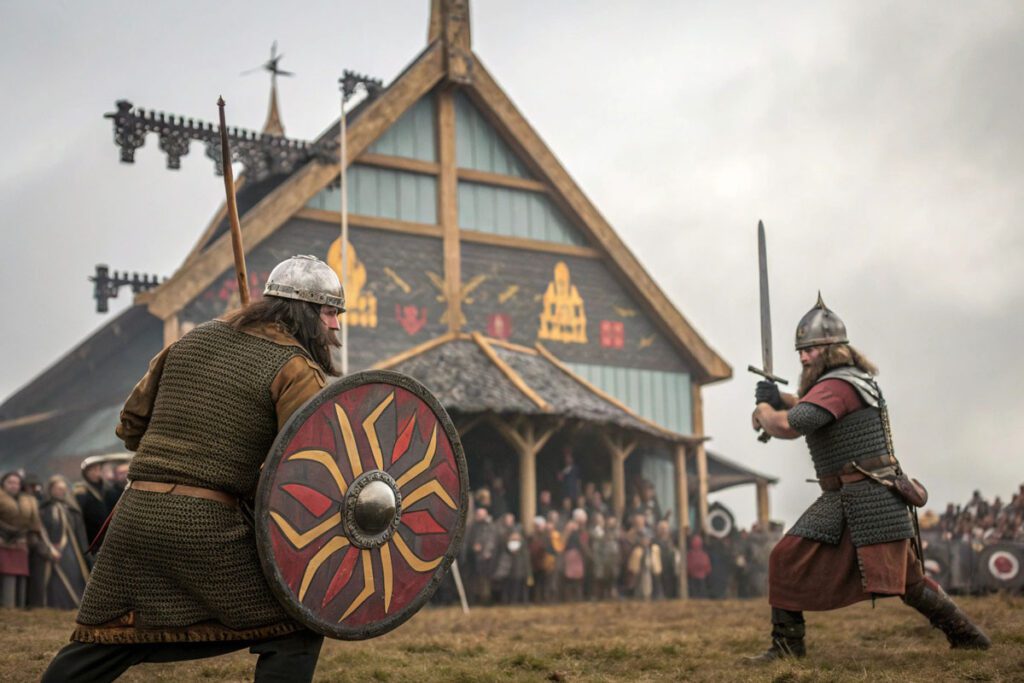
Filming Vikings in Ireland: Behind the Scenes
When fans think of Vikings, they often picture the towering fjords of Scandinavia—but in reality, most of the show was filmed far from Norway. The stunning backdrop of Ragnar’s world wasn’t the icy north—it was Ireland.
Why Ireland?
Ireland offered the perfect mix of wild landscapes, deep forests, and rugged mountains. But it wasn’t just about the scenery. Ireland’s established film industry, skilled crews, and generous tax incentives made it the ideal production base for an ambitious historical series like Vikings.
Ashford Studios: The Heart of Kattegat
Located in Ballyhenry, County Wicklow, Ashford Studios became the beating heart of the show. This is where the village of Kattegat was painstakingly built—from wooden longhouses and Viking ships to the iconic great hall. The set grew and evolved over the years, reflecting Kattegat’s rise from a fishing village to a powerful port.
Lough Tay – The Real Kattegat
Nicknamed the “Guinness Lake” for its dark waters and white-sand edge, Lough Tay doubled as the fjord-like setting of Kattegat. Surrounded by mountains and privately owned land, it gave the show’s creators the isolation and visual drama they needed. Drone shots and sweeping vistas made it one of the most recognizable locations in the series.
Other Key Filming Locations
Powerscourt Waterfall and Estate (Wicklow): Used for dramatic outdoor scenes and battle sequences.
Blessington Lakes: Often appeared in sailing and ship-launch scenes.
Nuns Beach (Kerry): Provided the coastal backdrop for raids and funerals.
River Boyne (Meath): Used in scenes showing river travel and Viking longboats.
Many of these areas are open to visitors and now feature on Vikings filming tours offered throughout the country.
Irish Talent On-Screen and Off
While the show featured international stars, Ireland contributed heavily to the cast and crew. Local actors appeared in supporting roles, extras, and battle scenes. Irish set designers, carpenters, costume makers, and makeup artists helped bring the Viking world to life with incredible attention to detail.
The Impact of Vikings on Irish Film Tourism
Thanks to Vikings, Wicklow became a filming hotspot and tourist destination. Fans still travel to walk the trails near Lough Tay or explore the grounds near Ashford Studios. The show’s success also helped boost Ireland’s reputation as a location for historical epics—paving the way for productions like Vikings: Valhalla, The Green Knight, and The Last Duel.
From behind-the-scenes magic at Ashford Studios to windswept battles on Irish beaches, Vikings brought Ireland’s landscape into the global spotlight. And even though Ragnar and Lagertha are gone, the echoes of their saga remain—in the hills, in the lakes, and in the hearts of fans who travel here to see where it all began.
Vikings Filming Locations You Can Visit in Ireland
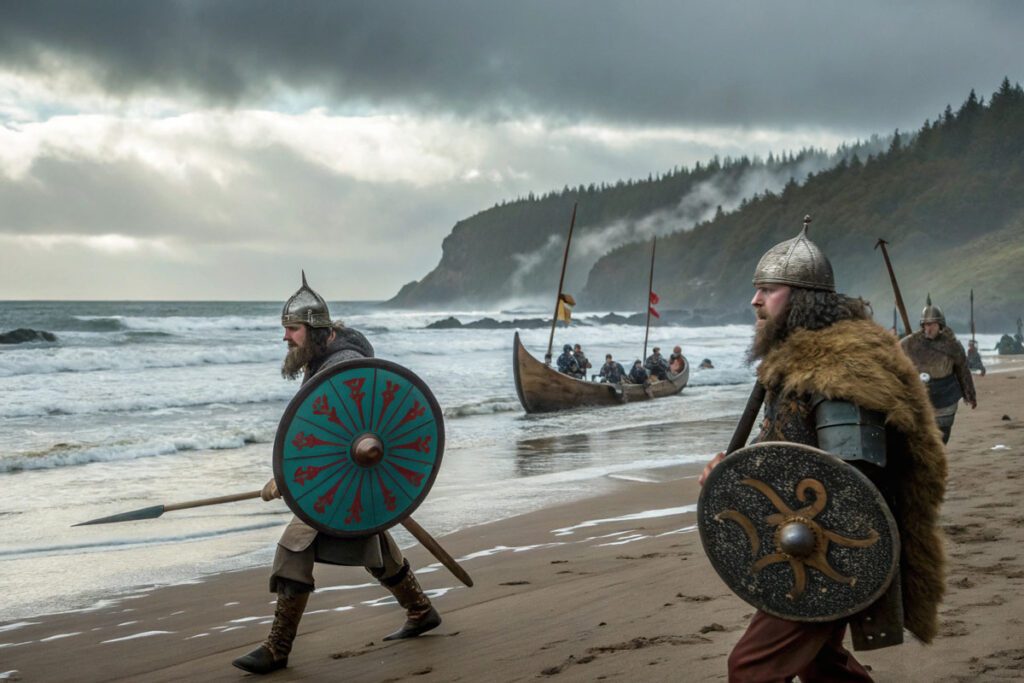
If you’ve ever dreamed of standing where Ragnar, Lagertha, or Bjorn once roamed, Ireland offers a chance to walk through the real-world settings of the Vikings TV series. While many scenes were shot on private land or within Ashford Studios, several key filming locations are open to the public—and they’re as breathtaking in real life as they are on screen.
1. Lough Tay (County Wicklow) – The Home of Kattegat
On-screen role: The iconic village of Kattegat
Why visit: Lough Tay, often called “Guinness Lake,” is framed by dramatic cliffs and nestled in the Wicklow Mountains. Though the actual Kattegat set was built on private land near the lake, the best views can be seen from nearby public walking trails like the JB Malone Memorial or the Ballinastoe Woods trail.
Tip: Bring binoculars—you can often glimpse remnants of old filming sites from afar.
2. Powerscourt Waterfall and Estate (County Wicklow)
On-screen role: Battle scenes and forest ambushes
Why visit: Ireland’s highest waterfall (121m) creates a powerful, cinematic backdrop. Surrounded by ancient woodland, it’s easy to imagine Viking warriors charging through the trees. The estate itself offers gardens and trails used in other historical productions as well.
Fun fact: Some scenes from The Tudors and Excalibur were also filmed here.
3. Blessington Lakes (County Wicklow)
On-screen role: Scenes involving river travel and longboat launches
Why visit: This stunning reservoir was used for calm-water scenes involving Viking ships. It’s a great area for kayaking, walking, and spotting wildlife—and for imagining fleets of Norse ships quietly slicing through the mist.
Access: Easily reachable from Dublin (under an hour’s drive).
4. River Boyne (County Meath)
On-screen role: Longship journeys and riverside battles
Why visit: A river steeped in Irish mythology and history, the Boyne was used in scenes where Viking fleets journeyed inland. While specific filming sites along the river are harder to pinpoint, the surrounding landscape captures the feel of the series—and nearby heritage sites like Newgrange add depth to your trip.
5. Nuns Beach (County Kerry)
On-screen role: Coastal raids and beach scenes
Why visit: Tucked near the town of Ballybunion, this dramatic, secluded beach with sea stacks and cliffs is perfect for imagining Viking landings. It’s a lesser-known spot and gives a wild, untamed feel—just like in the show.
Note: Access can be tricky; local guides or tours may be the best way to explore it safely.
6. Ashford Studios (Ballyhenry, Wicklow)
On-screen role: The heart of all production
Why visit: While not open to the public, Ashford Studios is the place where Kattegat and many key sets were built. It’s located near several walkable areas used for outdoor scenes, and some local tour companies offer Vikings-themed experiences nearby.
Planning Your Viking Journey
Best Time to Visit: Spring and early autumn offer great weather and fewer crowds.
How to Explore: Self-drive itineraries work well, or you can book a guided Vikings filming tour from Dublin or Wicklow.
Bonus Sites: While not directly featured in the show, visiting Dublin’s Viking Quarter or the Waterford Viking Triangle can add historical depth to your trip.
Whether you’re retracing the steps of legendary characters or simply soaking in the Irish scenery, these filming locations bring Vikings to life in a whole new way. With every hill, forest, and shoreline, you’ll feel closer to the saga.
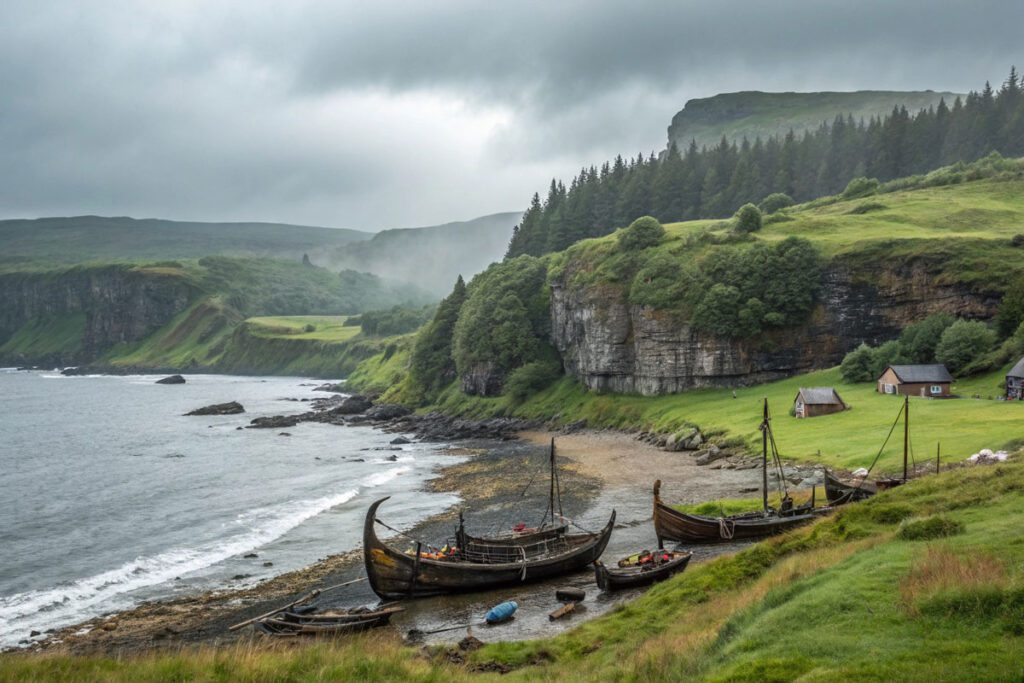
Vikings: Valhalla and Ireland’s Ongoing Role
The saga didn’t end with Ragnar and Lagertha. In 2022, Vikings: Valhalla launched on Netflix as a sequel to the original Vikings series—set over 100 years later and centered on a new generation of Norse heroes. Just like its predecessor, Valhalla once again turned to Ireland to bring its world to life.
Ireland Returns as a Star Location
While the story now follows historical figures like Leif Erikson, Freydís Eiríksdóttir, and Harald Sigurdsson, the production team returned to familiar ground: Ireland’s rugged wilderness and expert crews.
Filming Base: Valhalla is also filmed at Ashford Studios in County Wicklow, where new sets were constructed to reflect a different era of Viking society—more global, more Christianized, and more complex.
Landscapes: Many outdoor scenes again use Wicklow’s forests, rivers, and mountains to stand in for locations across Scandinavia and England.
Set Design: Unlike the original show, Valhalla portrays a more structured Viking world—with cities like Kattegat appearing larger and more fortified.
Continuing Ireland’s Film Industry Legacy
Valhalla is part of a growing trend of high-profile productions choosing Ireland for its mix of natural beauty, historical resonance, and strong film infrastructure. The country has solidified its reputation as a home for:
Historical dramas
Fantasy epics
Large-scale period pieces
Ireland’s role in Vikings: Valhalla has also boosted local jobs and tourism, with fans visiting familiar filming sites or joining Valhalla-themed location tours.
How Valhalla Builds on the Viking-Irish Story
Although Valhalla shifts focus to broader European events—like the fall of England to the Normans or Norse exploration of the Atlantic—there are strong thematic echoes of Ireland’s historical past:
Conflict between Christianity and paganism plays a central role—mirroring real tensions that once divided Irish and Norse communities.
Viking Dublin’s legacy lives on indirectly through storylines involving Norse rulers and their far-reaching influence.
While Ireland doesn’t feature as prominently in the Valhalla narrative itself, its presence behind the scenes is essential to the series’ look and feel.
The Future of Viking Ireland On-Screen
With Valhalla already renewed through three seasons, Ireland’s role in the Viking cinematic universe continues to grow. There’s potential for spin-offs, documentaries, and increased tourism tied to the filming locations and real Viking heritage.
Ireland remains not only a filming location, but a silent character in the ongoing Viking legend. As Valhalla continues to tell new stories of conquest, faith, and exploration, the hills and valleys of Wicklow—and the spirit of Norse-Irish history—are never far from the frame.
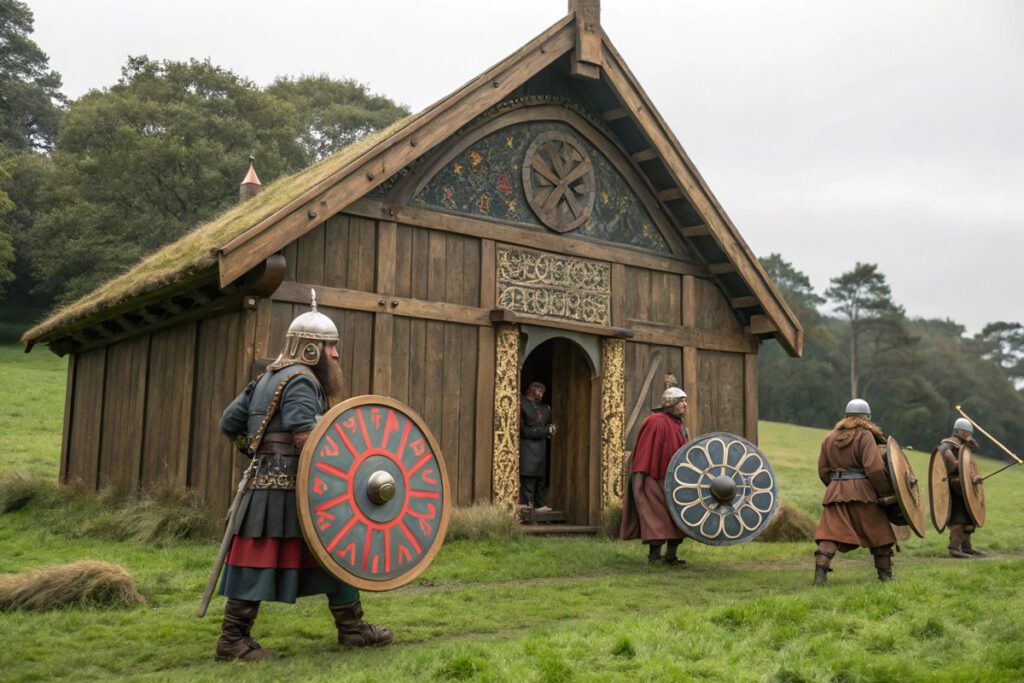
Pop Culture Meets Heritage: Vikings in Irish Tourism and Identity
The Vikings series didn’t just entertain millions—it transformed how people around the world view Ireland’s Viking past. What was once the domain of academics and museum-goers has become part of popular culture, travel itineraries, and even local pride.
TV Series as a Gateway to History
For many visitors, the Vikings and Valhalla series serve as a first introduction to Ireland’s Norse legacy. While the shows take dramatic liberties, they spark curiosity and invite fans to dig deeper into real events and places—often leading to visits to:
Dublin’s Viking Quarter
Waterford’s Viking Triangle
The National Museum of Ireland’s Viking exhibits
Historic sites like Clontarf and Wood Quay
Popular culture has become a bridge between fiction and fact.
Viking-Themed Tourism in Ireland
The surge in interest has led to a wave of themed experiences across the country:
Walking Tours in Dublin explore Viking street names, ship excavations, and Norse burials beneath the modern city.
Reenactment Festivals, like the Dublinia Viking Festival and Wexford’s Irish National Heritage Park events, bring Viking life to the streets.
Filming Location Tours in Wicklow let fans stand where their favorite characters once fought, feasted, or fell in battle.
Some local businesses now embrace the theme, offering Viking-themed pubs, axe throwing, and costumed photo ops.
Museums and Authentic History
While TV dramatizes, museums clarify. Ireland’s institutions work to correct myths while embracing public interest:
Dublinia (in Dublin) offers interactive exhibits on Viking daily life, archaeology, and urban development.
National Museum of Ireland – Archaeology houses treasures like the Wood Quay finds, Viking swords, and the famous Oseberg-style ships.
By combining pop culture and genuine scholarship, these places deepen appreciation for the Viking influence on Irish identity.
Local Identity and Norse Roots
In cities like Waterford and Limerick, Viking heritage is no longer just a historical footnote—it’s a point of local identity. You’ll see Norse symbols in street art, tourism campaigns, and educational programs. For modern Irish people, the Viking legacy is becoming part of a broader story of multicultural Ireland—an early chapter in a long history of invasion, integration, and resilience.
From battle scenes on-screen to festivals in city streets, Vikings has helped Ireland rediscover and reimagine a fierce and fascinating chapter of its past. Pop culture may simplify history, but when it’s done well, it can also revive it—and in Ireland, the Viking age is alive once more.
Reliving Viking Times at Waterford’s Viking Triangle: A Cultural Hub of Heritage
Timeless Echoes: Rediscovering Viking Times at Waterford Viking Triangle In the enchanting embrace of Ireland’s southeast, where the River Suir and the sea intertwine in a dance of time, lies a town that breathes history – Waterford. With each cobblestone underfoot,...
Read More

